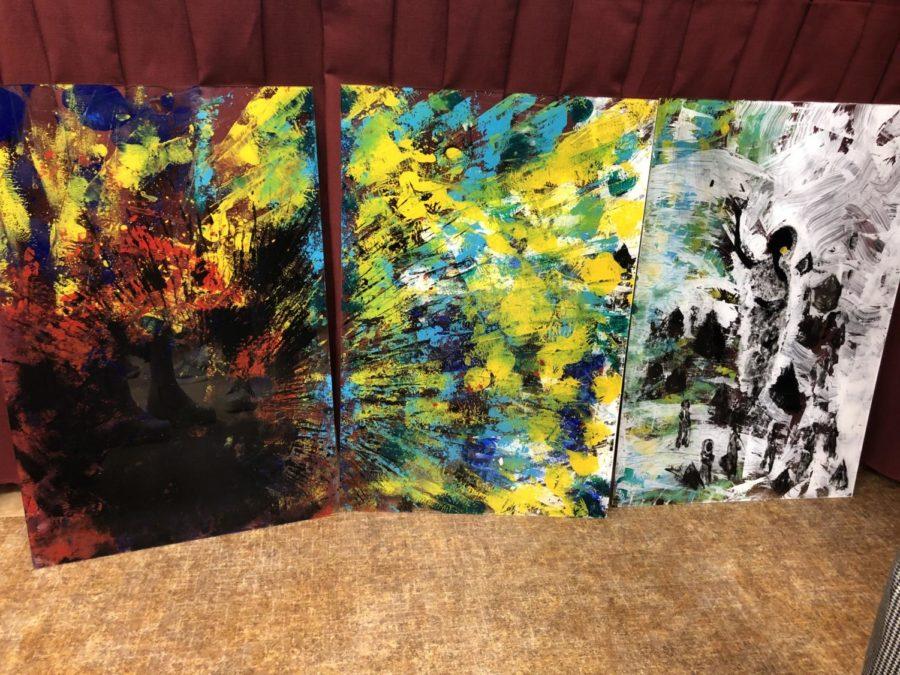Westberg: Student art brings light to controversies
Hiba Salih’s multi-panel artwork “Revolution,” pictured above, represents all the issues that occurred during the division between North and South Sudan.
April 25, 2019
Art has always been a way for people to express thoughts bigger than they can explain with words. Some people get their inspiration for art through music and some through drawing, but sometimes the best ideas come from classroom doodles or things that you do. Last week I covered the International Student Council’s (ISC) events held earlier this month to spread awareness and shed light on all of the cultures at Iowa State. While attending these events I met many amazing people who were willing to teach me about their culture. I also met some whose experiences with their own culture and different cultures inspired a variety of different art pieces.
The art exhibited by the students from Sudan ranged in medium, size and color, but they all also reflected upon different things occurring in their country today. While my encounters with Hiba Salih and Shance Bagos Taylor were brief, their pieces reflected on very serious and pressing issues in Sudan. Salih exhibited two separate multi-panel acrylic sheets with paint on them entitled “Revolution” to reflect on the 2011 split of North and South Sudan when many riots and conflicts were occurring. I also got the chance to speak with Taylor about his memorial piece to the people who were incarcerated and killed during the riots and protests during the split of Sudan. The painting shows pink strokes for everyone incarcerated, while the blue strokes represent people who were killed during their incarceration.
I also had the opportunity to more formally interview Rami Mannan, a senior in Architecture from Sudan whom I met while attending the ISC student facilitated lecture, “Countries of Conflict.” After the lecture was over people who attended got a chance to speak with the students who spoke on behalf of their country and get more information on what is happening in our world. The group of students from Sudan brought along some art pieces that were inspired by things that were happening in their country, as well as in the world around us and their hopes for the future. Mannan showcased a piece inspired by smoke associating the clouds with connections made by people.
When asked about the direct inspiration for the piece, Mannan said, “The piece was inspired by a prequel drawing that I created as a response to the 2019 Venice Biennial’s theme, ‘Atmosphere.’ My response was a 9′ by 5′ drawing that studied smoke as I’m a smoker and it is my personal interaction with the atmosphere. I looked at Da Vinci’s drawings of moving water and stormwater to showcase and document movement of smoke.”
Mannan said that the piece took him over 14 hours for the initial piece to be created and spent countless hours of tweaking, recreating and reshaping the final product. The piece was inspired by a variety of different conflicts in our world that Mannan hoped to bring light, such as wars, disassociation between people and a plethora of environmental issues.
Mannan tackled the tough job of explaining the full meaning of the piece by saying, “The piece uses smoke as a medium to talk about how interconnected we are as a species. All the world issues affect us somehow, whether it be indirectly or directly. Whether it be world powers meddling in developing countries’ politics which result in political unrest leading to refugee crises that affect the leading world powers directly through a surge of migration. Or in the event of the melting ice caps in Antarctica and how that is affecting us as a whole through rampant effects of climate change and global warming.” The piece may be small but holds a lot of meaning.
The cloud of smoke is meant to resemble Pangea when all of the continents were still together as a whole, thus embodying the connection between people regardless of race, religion or any other differentiating factor. The darker spots where lines are more concentrated were aimed to be of the regions in the world where more conflict is happening, which Mannan said was to put an emphasis on the variety of world issues.
Art is an amazing way to get people talking about issues, whether it be through a controversial piece or something that started as a classroom doodle, issues can always be brought to the light through art. As my encounter with Mannan came to a close he said, “If everyone takes a step to make a change and let people in by informing them about the issues we are facing today, they will realize the change that they can make.”

















